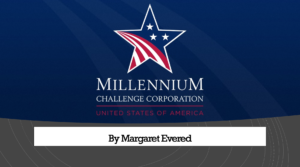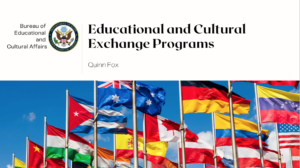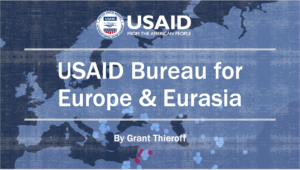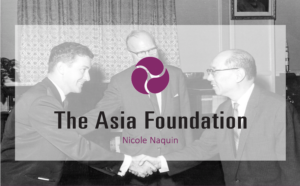
At the USGLC, we are all about America’s diplomacy and development, including the International Affairs Budget (IAB) and how its programs strengthen America’s leadership around the world and are a strategic investment in our country’s health, economic, and security interests. At 1% of the total federal budget, international affairs funding is responsible for supporting many different agencies and programs, from USAID and the State Department to the Peace Corps and global health and foreign assistance.
Each semester, we recruit an ambitious team of interns to help us advocate for American diplomacy and development around the world—and the international affairs funding that supports U.S. global engagement—as part of the USGLC’s internship program. As a capstone of the internship experience, our interns dive into different aspects of the budget, selecting and researching an international affairs program and then presenting their findings to the entire USGLC staff. Not only do USGLC’s interns learn more about these important endeavors, but they also help develop professional skills like research, writing, presenting, and public speaking that will be useful in future career settings.
Here in their own words, our spring class of interns provide highlights of their presentations on global health programs, the Millennium Challenge Corporation, the State Department’s educational and cultural exchange programs, USAID’s Bureau for Europe and Eurasia, and the Asia Foundation—helping to show the range and diversity of U.S. international affairs programs and how their funding impacts Americans and other people around the world.
Jointly managed by USAID and the State Department, the Global Health Programs support initiatives that combat the HIV/AIDS epidemic, fight infectious diseases, and prevent child and maternal deaths—ultimately promoting the stability of communities and nations, while advancing American security and prosperity. Two of the largest and most notable Global Health Programs are the President’s Emergency Plan for Aids Relief (PEPFAR) and The Global Fund.
Since 2003, PEPFAR has worked to prevent HIV infection and help countries better control the HIV epidemic, ultimately saving more than 20 million lives worldwide. PEPFAR has also partnered with Merck and the Joint United Nations Programme on HIV/AIDS on the Go Further program to end AIDS and cervical cancer in HIV-positive women—with more than one million women receiving cervical cancer screenings in 12 countries across Africa.
The Global Fund is a partnership designed to accelerate the end of AIDS, tuberculosis, and malaria by investing in community-level solutions and creating resilient health systems. Since 2002, the fund has worked in 155 countries and saved more than 38 million lives. The Global Fund’s “Resilient and Sustainable Systems for Health” strategy has resulted in a significant decrease in the presence of malaria in Niger, and the construction of 15,000 village-level health care centers across Ethiopia.
 President George W. Bush established the Millennium Challenge Corporation (MCC) in 2004 as a new major global development agency separate from USAID and the State Department that focused on leading the fight against global poverty and creating sustainable economic development abroad.
President George W. Bush established the Millennium Challenge Corporation (MCC) in 2004 as a new major global development agency separate from USAID and the State Department that focused on leading the fight against global poverty and creating sustainable economic development abroad.
In many ways, the MCC has accomplished President Bush’s goal to become an innovative and independent U.S. foreign assistance agency and has enjoyed broad bipartisan support in Congress since its creation. The MCC has a competitive selection process to decide which countries receive assistance through “compacts” or aid grants. This process evaluates a country’s performance against 20 different policy indicators to determine their eligibility for a compact and ensure they are responsible aid recipients. As part of the process, the MCC also requires countries to identify their own priorities for projects—such as infrastructure and education—and works closely with local teams on project implementation, helping to create local jobs.
MCC offers three different types of grants, but the most common is the five-year compact grant. As one example, MCC awarded a compact grant to Moldova in 2010 focused on renewing the country’s agriculture and road infrastructure, which were constraining overall economic growth. The Transition to High Value Agriculture Project helped remove these barriers by repairing roads, improving access to water, and moving toward more high-value grains—benefitting an estimated 414,000 people.
At the end of each compact, MCC publishes extensive evaluations on their website and reflects on the successes and failures of the projects, which they incorporate into future compacts.
 Created by the Mutual Educational and Cultural Exchange Act of 1961, the State Department’s Bureau of Educational and Cultural Affairs (ECA) hosts a variety of exchange programs for Americans and foreign citizens alike. ECA uses these exchange programs to increase mutual understanding and foster peace between the United States and other nations, as well as strengthen alliances and partnerships.
Created by the Mutual Educational and Cultural Exchange Act of 1961, the State Department’s Bureau of Educational and Cultural Affairs (ECA) hosts a variety of exchange programs for Americans and foreign citizens alike. ECA uses these exchange programs to increase mutual understanding and foster peace between the United States and other nations, as well as strengthen alliances and partnerships.
With a total of 80 programs sponsored by the ECA, there is a variety of offerings that appeal to people of different age groups, career paths and interests—involving over 55,000 participants annually, including 15,000 Americans. Some well-known ECA programs include Critical Language Scholarships, the Fulbright Scholarship, and the International Visitor Leadership Program. The Critical Language Scholarship provides overseas language education for American graduate and undergraduate students, while the Fulbright Scholarship offers fellowships to U.S. undergrads and graduate students, young professionals, and artists to study, conduct research, or teach English in 160+ countries. Alternatively, the International Visitor Leadership Program invites current and emerging foreign leaders for short visits to the U.S. to help cultivate lasting relationships with Americans through professional meetings and cultural excursions.
The alumni of these exchange programs boast impressive resumes and often go onto hold influential positions in their own countries. Of the 1 million exchange program alumni, there are over 570 current and former heads of government, 105 Pulitzer Prize winners, 64 current and former representatives to the UN, and 97 current or former members of U.S. Congress.
 For over 30 years, USAID’s Bureau for Europe and Eurasia (E&E) has worked in post-Communist states throughout the former Eastern Bloc and Balkan region. Created to help these countries move away from communism, the Bureau region investments have helped to de-centralize industry and governance, promote energy and economic independence, and build democratic and civil society resilience.
For over 30 years, USAID’s Bureau for Europe and Eurasia (E&E) has worked in post-Communist states throughout the former Eastern Bloc and Balkan region. Created to help these countries move away from communism, the Bureau region investments have helped to de-centralize industry and governance, promote energy and economic independence, and build democratic and civil society resilience.
Because of these investments, Europe and Eurasia are the sites of some of USAID’s greatest successes in recent decades. Of the Bureau’s original 24 partner countries, 11 countries have reached sufficient development and no longer need assistance, while four others have themselves become donor countries.
Nevertheless, the region faces new and unique challenges. Widespread corruption and expanding Russian influence campaigns have left the democracies of developing countries in this region vulnerable amid a global rise in authoritarianism. To combat this, USAID has doubled down on its civil society investments through initiatives like the Transparency and Accountability in Public Administration and Services (TAPAS) program to promote transparent government procurement in Ukraine, and the U.S. Albania Transparency Academy to build civil society resilience in Albania.
Between current investments and delivered results—including an increase of U.S. exports to the region from $2 billion to over $10 billion in 2015 alongside regional economic growth and progress—the USAID’s regional efforts are proving to be a continued success for both the American and European people.
 The Asia Foundation is a global non-profit organization working to promote development and prosperity throughout Asia and deliver aid, education and advisory services to communities in need. The Foundation’s work centers around addressing six issues that threaten the success of development efforts in the region: lack of reliable governance, persistent poverty and income inequality, human rights violations, climate change, exclusion of women from positions of power, and ethnic and religious conflicts. Through its partnerships with organizations such as USAID and the State Department, the Asia Foundation also works to strengthen relationships between Eastern and Western countries.
The Asia Foundation is a global non-profit organization working to promote development and prosperity throughout Asia and deliver aid, education and advisory services to communities in need. The Foundation’s work centers around addressing six issues that threaten the success of development efforts in the region: lack of reliable governance, persistent poverty and income inequality, human rights violations, climate change, exclusion of women from positions of power, and ethnic and religious conflicts. Through its partnerships with organizations such as USAID and the State Department, the Asia Foundation also works to strengthen relationships between Eastern and Western countries.
Started in 1954, the Asia Foundation’s signature Books for Asia program has assisted in the education of youths and research of academics in the region for over 60 years. Tens of millions of books and academic journals have made their way to Asian schools and universities in the past few decades, and the Foundation’s new free digital library expands the programs reach to over 130 countries. The Books for Asia program supplements the many different education initiatives that the Foundation has led over the years, helping to increase America’s soft power and influence in the region and generate pro-American sentiments among government entities.
For more information about the International Affairs Budget, visit our Budget Center.
For more information about USGLC’s internship program, visit our Internships page.